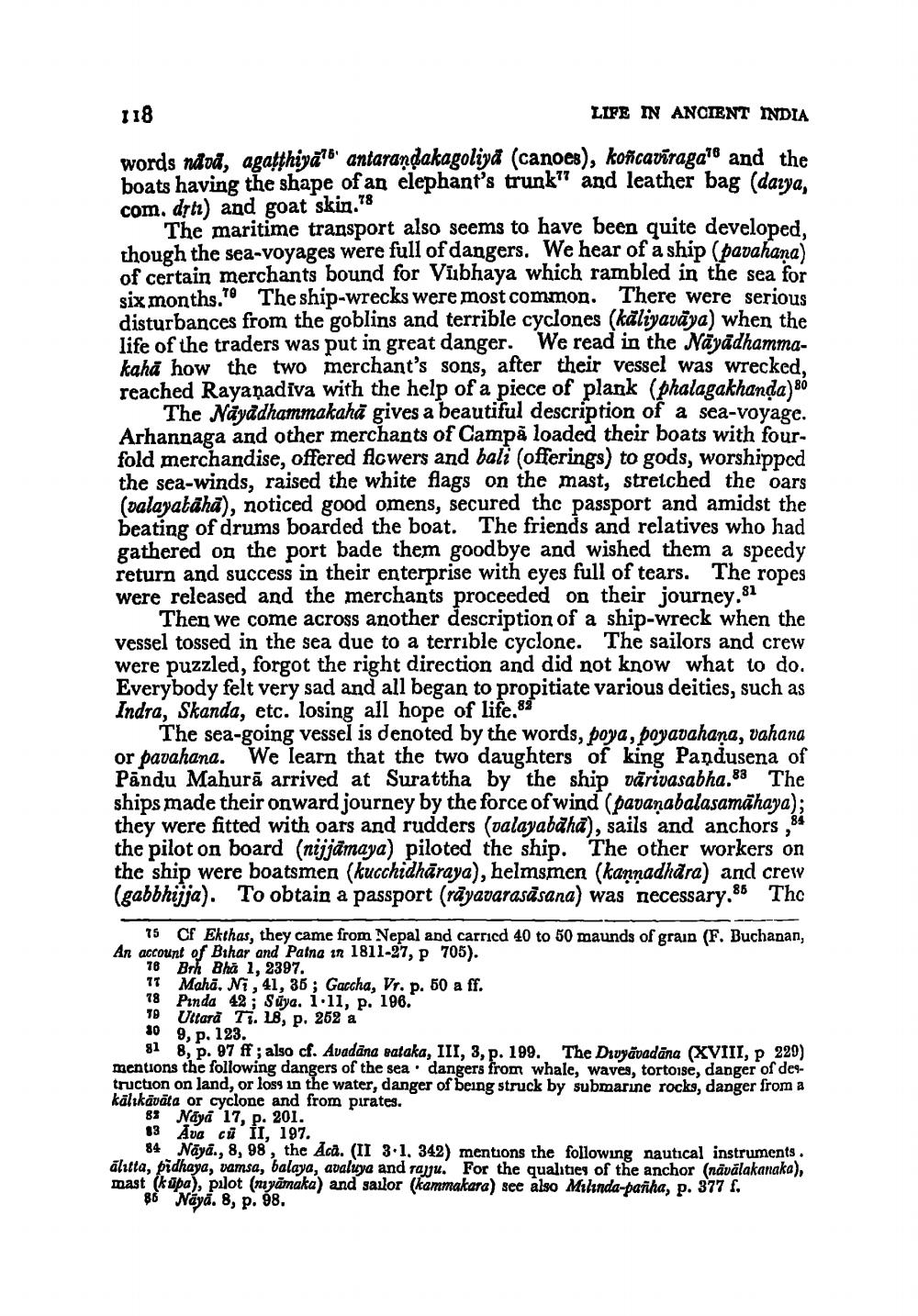________________
118
LIFE IN ANCIENT INDIA
words ndod, agałthiya?' antarandakagoliya (canoes), koñcavīragats and the boats having the shape of an elephant's trunk" and leather bag (dazya,
com. ditz) and company of an elephant'canoes), koñcavirapte ..
The maritime transport also seems to have been quite developed, though the sea-voyages were full of dangers. We hear of a ship (pavahana of certain merchants bound for Vibhaya which rambled in the sea for six months. The ship-wrecks were most common. There were serious disturbances from the goblins and terrible cyclones (kāliyavāya) when the life of the traders was put in great danger. We read in the Nayadhammakaha how the two merchant's sons, after their vessel was wrecked, reached Rayañadiva with the help of a piece of plank (phalagakhanda só
The Nayadhammakahā gives a beautiful description of a sea-voyage. Arhannaga and other merchants of Campă loaded their boats with fourfold merchandise, offered flowers and bali (offerings to gods, worshipped the sea-winds, raised the white flags on the mast, stretched the oars (valayatāhā), noticed good omens, secured the passport and amidst the beating of drums boarded the boat. The friends and relatives who had gathered on the port bade them goodbye and wished them a speedy return and success in their enterprise with eyes full of tears. The ropes were released and the merchants proceeded on their journey.81
Then we come across another description of a ship-wreck when the vessel tossed in the sea due to a terrible cyclone. The sailors and crew were puzzled, forgot the right direction and did not know what to do. Everybody felt very sad and all began to propitiate various deities, such as Indra, Skanda, etc. losing all hope of life.83
The sea-going vessel is denoted by the words, poya, poyavahana, vahana or pavahana. We learn that the two daughters of king Pandusena of Pandu Mahurā arrived at Surattha by the ship värivasabha.83 The ships made their onward journey by the force of wind (pavanabalasamahaya); they were fitted with oars and rudders (oalayabdha), sails and anchors, 84 the pilot on board (nijjāmaya) piloted the ship. The other workers on the ship were boatsmen (kucchidhāraya), helmsmen (kannadhāra) and crew (gabbhijja). To obtain a passport (rayavarasāsana) was necessary.86 The
75 Cf Ekthas, they came from Nepal and carried 40 to 50 maunds of grain (F. Buchanan, An account of Bihar and Patna in 1811-27, p 705).
78 Brh Bhā 1, 2397. 11 Maha, Ni, 41, 36; Gaccha, Vr. p. 50 a ff. 78 Pında 42; Suya. 1.11, p. 196.
Ultară Ti. L8, p. 252 a 309, p. 123.
81 8, P. 97 ff; also cf. Avadana sataka, III, 3, p. 199. The Drvyāvadāna (XVIII, P 229) mentions the following dangers of the sea. dangers from whale, waves, tortoise, danger of destruction on land, or loss in the water, danger of being struck by submarine rocks, danger from a kälikäväta or cyclone and from pirates.
83 Naya 17, p. 201. 33 Ava cū II, 197.
84 Nāya., 8, 98, the Aca. (II 3.1, 342) mentions the following nautical instruments. álitta, pidhaya, vamsa, balaya, avaluya and rajju. For the qualities of the anchor nāválakanaka), mast (kupa), pilot (nayāmaka) and sailor (kammakara) see also Milinda-pariha, p. 377 f,
86 Naya. 8, p. 98.




